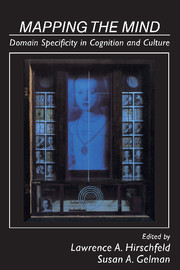Book contents
- Frontmatter
- Contents
- List of contributors
- Preface
- Part I Overview
- Part II The origins of domain knowledge: Biology and evolution
- Part III The origins of domain knowledge: Conceptual approaches
- Part IV Are domains theories?
- Part V Domains across cultures and languages
- Part VI Implications for education
- 18 Teachers' models of children's minds and learning
- 19 Situated rationalism: Biological and social preparation for learning
- Author index
- Subject index
18 - Teachers' models of children's minds and learning
Published online by Cambridge University Press: 04 August 2010
- Frontmatter
- Contents
- List of contributors
- Preface
- Part I Overview
- Part II The origins of domain knowledge: Biology and evolution
- Part III The origins of domain knowledge: Conceptual approaches
- Part IV Are domains theories?
- Part V Domains across cultures and languages
- Part VI Implications for education
- 18 Teachers' models of children's minds and learning
- 19 Situated rationalism: Biological and social preparation for learning
- Author index
- Subject index
Summary
Laypersons, teachers, and psychologists believe that learning takes place in people's minds. They all believe that learning takes place as a consequence of instruction, if we interpret instruction in its widest sense (Atran & Sperber, 1991).
Western laypersons have folk psychology notions of the mind and its functioning. But their notions are not all that naive because Western adults have considerable practice at learning and, even more important, thinking about learning. Entry into school, the culturally designated place for learning to take place, generally begins at age 6. Thus students who have finished their high school education have been in formal learning situations for 12 years. Over a considerable period of time, then, they have practiced what they and others think it takes to learn. In the sense that they have not studied formally about the mind and learning in, say, psychology courses, they can be considered laypersons. But it is a big stretch to call them laypersons and holders of a naive psychology after they have been in places where learning is the main goal and where they have been reflective about what that learning is.
Teachers are professionals who have been educated to teach in such a way as to cause change in others’ minds. That change is learning. The cause of that change is thought to be teaching. The differentiation between teaching and learning is often unclear, even in the educational literature. Some of our best friends refer to it as the teaching/learning process.
- Type
- Chapter
- Information
- Mapping the MindDomain Specificity in Cognition and Culture, pp. 455 - 473Publisher: Cambridge University PressPrint publication year: 1994
- 40
- Cited by



